""""[vc_column_text]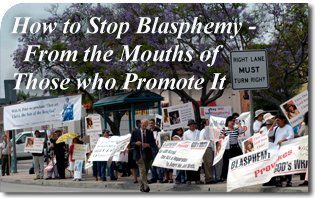 When artist Alma Lopez displayed her “art” exhibit titled “Our Lady” in February of 2001, she did not expect protests. But the display of an image of Our Lady of Guadalupe in a floral bikini did raise an outcry. Tens of thousands of devout Catholics came to the defense of Our Lady.
When artist Alma Lopez displayed her “art” exhibit titled “Our Lady” in February of 2001, she did not expect protests. But the display of an image of Our Lady of Guadalupe in a floral bikini did raise an outcry. Tens of thousands of devout Catholics came to the defense of Our Lady.
The protest caused such an uproar that the Museum of International Folk Art in Santa Fe, New Mexico was forced to cut the exhibit short by four months. For nearly eight years Alma Lopez’s exhibit has not been seen – no museum would touch it.
One year later, the American Association of Museums (AAM) held its 96th Annual Meeting in Dallas. One of the featured panel discussions was about the Sante Fe controversy and why the defenders of Our Lady were so effective. The discussion was a veritable how-to manual about making effective protests.
Now Alma Lopez is showing the same picture at the Oakland Museum of California and protests are mounting. The conclusions of the panel discussion need to be applied.
Here is the first-hand account of the AAM meeting that shows how effective a protest can be – from the mouths of those on the other side of the museum door.
Read this report and learn how to stop blasphemy.[/vc_column_text][/vc_column][/vc_row]""""[vc_message message_box_color=”grey” icon_fontawesome=”fa fa-volume-up”]
“Accept that you are not going to win. There is no win in such a controversy. You’re just going to survive. Those are the facts. It’s not pretty, but those are the facts.”1
[/vc_message][/vc_column][/vc_row]""""[vc_column_text]
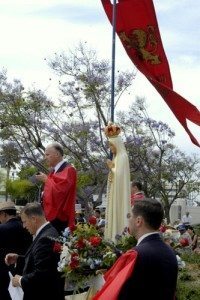
are often told they are just giving
free publicity to the offending work. The truth, however, is quite the contrary – as the other side tells us.
Such was the counsel of journalist Hollis Walker to museum directors and curators regarding protests against blasphemous art. Her comments run quite contrary to what protesters are frequently led to believe.
Indeed, Catholics who protest blasphemy are often told that they are ineffective since the offending piece is rarely removed. At best, they are told, their anti-blasphemy efforts are but symbolic gestures. Others dismiss all protesting as free publicity for the offending work.
The arts establishment pretends not to notice protesters and makes it seem that the protesters’ efforts are of no avail.
Rarely does the protester see what actually happens on the other side of the museum doors when blasphemy is displayed. Piercing the silence, however, can be quite revealing.
Piercing the Silence
The American Association of Museums (AAM) held its 96th Annual Meeting in Dallas on May 12-16, at the Dallas Convention Center. More than 5,000
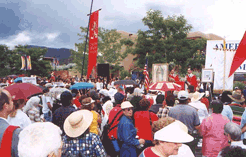
museum professionals representing approximately 1,000 museums from every state and 30 foreign countries convened in what was termed “the largest cultural gathering in the world.”
This august forum was the scene of a panel discussion that shows just how seriously the arts establishment takes anti-blasphemy protesters.
“I felt I was at a secret meeting of the opposition,” said TFP observer James Miller, who attended the event. “I couldn’t believe how they just said everything. It was like being on the other side of the museum door during the protest.”
Even more revealing was the fact that the panel focused on the controversy surrounding a blasphemous portrayal of Our Lady of Guadalupe in Santa Fe, New Mexico, in February of 2001. The American Society for the Defense of Tradition, Family and Property (TFP) and its America Needs Fatima campaign worked together with local activists to protest the portrayal. The rally gathered nearly a thousand Catholics.

“Our Lady of Controversy”
“Our Lady of Controversy: The Cyber Arte Exhibition at the Museum of International Folk Art” was the very suggestive title of the panel discussion. Various experts from the museum field were selected to speak to the audience on how to deal with protests against blasphemy.
As the title suggests, the panel’s purpose was to discuss the controversy that surrounded Alma Lopez’s “Our Lady” at Santa Fe’s Museum of International Folk Art. Press reports described the exhibit as a computer collage portraying a bikini-clad Virgin of Guadalupe held aloft by a topless female angel.
For months, this “artwork” divided the community. The June 30 rally in front of the museum united offended Catholics from all over New Mexico and at least seven other states. The America Needs Fatima campaign mobilized tens of thousands nationwide to send “Enough is enough!” protest postcards. The TFP website asked supporters to send instant e-mail protests. The effort received letters of support from bishops, priests, and national conservative figures, including congressmen.
“Completely Vulnerable”
The panel speakers stressed that controversy is extremely upsetting and outlined some tactics for dealing with the problem. Above all, it became very clear that they do not view protests as free publicity.
“I was amazed to hear them confess how utterly vulnerable they felt,” reported Mr. Miller. “They really take protests seriously.”
Indeed, the panel moderator complained that museums are naïve about their work and totally unprepared to deal with such controversies. Panelists reported their own helplessness in explaining to the public their reasons for airing blasphemy. They noted how one scene of a protester praying a rosary on the evening news had the effect of erasing any sympathy for the museum from the viewing public.
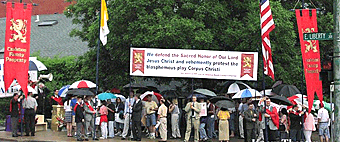
They were especially exasperated by the fact that the museum was constantly on the defensive and could never break out of the media siege.
How Effective Protests Are
Ironically, all the myths about blasphemy protests were destroyed by the very people who display such works. They testified that protests are not just symbolic gestures or free publicity but effective statements that echo throughout the arts community.
Alma Lopez, creator of “Our Lady,” speaking on the panel, admitted that it was “difficult and hard to go through all this.” She received hundreds and hundreds of e-mails per day from offended Catholics and even from children. The controversy surrounding her unpopular work left her perplexed and “marginalized.” “People are really paying attention to them,” she complained, “and our voices are not being heard at all.”
“The press with the twenty-second sound byte just kills you,” commented John McCarthy, deputy director of the Folk Art Museum. “There is no way you can present your story.”
Because of the work of a few dedicated protesters, everyone from the governor’s office to the museum regents were suddenly concerned. The controversy became national and even international news.
Uncompromising Protest
Panel speakers were also impressed by the organization of the protesters. They presented slides and video clips to illustrate the point.
They were surprised by the fact that the protesters were “more coordinated” than they were. Everywhere they turned they met opposition and “organized loud protest.”
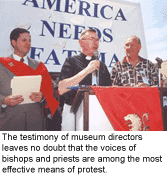
Deputy Director McCarthy showed the national projection of the controversy by admitting that the museum received over 65,000 “Enough is enough!” protest postcards from the TFP effort. They were still coming months after the exhibit came down.
The museum directors had hoped to diffuse the controversy by entering into dialogue and compromise with protesters. The unbending attitude of the protesters left them empty-handed.
In fact, it was the directors who eventually made concessions. They canceled the four-month extension they had planned for the exhibit, closing it on the originally scheduled date. Even so, the protesters were still not satisfied.
“How serious do you take these people?” Mr. McCarthy asked, then answered himself: “Very serious!” He further noted that the museum was always unprepared, especially since the protesters “never, never gave in on any point.”
It is important to note as well that the panelists acknowledged how important it is for the local bishop to speak out against blasphemy. The fact that Archbishop Michael Sheehan of the Santa Fe Archdiocese condemned the work at the beginning of the showing caused irreparable damage to the museum public relations campaign.
“If only bishops and priests realized just how effective their protest could be!” commented Mr. Miller after the session. He observed how panelists qualified the Archbishop of Santa Fe as one of the “most powerful people in the state of New Mexico.” His condemnation was hardly free publicity.
Journalist and panel member Hollis Walker bluntly told the audience that blasphemy protests are no-win situations for museums. Their best policy is defense and damage control.[/vc_column_text][/vc_column][/vc_row]""""[vc_message message_box_color=”grey” icon_fontawesome=”fa fa-volume-up”]
“At the very beginning, if you see something like this erupting, my best advice to you is to go hire the best public relations crisis consultant you can find,” she stressed, “because the internal public relations and marketing people at museums are not equipped to deal with this kind of issue.”
[/vc_message][/vc_column][/vc_row]""""[vc_column_text]
Long-Term Consequences
The consequence of a blasphemy protest goes beyond the time the exhibit is displayed. Controversy sends shock waves throughout the arts community. The ugliness of blasphemy is such that people tend to disassociate themselves from it when it is exposed.
Dr. Joyce Ice, director of the Folk Art Museum’s Office of Cultural Affairs, told the audience how controversy affects the judgment of museum directors. She pointed out “that the danger now lies not so much in being silenced but to censor ourselves in the future.”
Journalist Hollis noted that the large art community in Santa Fe remained silent during the controversy. While Catholics united and proudly stood behind Our Lady of Guadalupe, the local arts establishment did very little to come to the aid of their fellow artist.
Museum Director Tom Wilson pointed out that the controversy created a rift with the local community. Months after the exhibit came down, the wounds were still open. “We have not completely finished the healing process, or maybe in some ways you can say we haven’t really begun it,” he said.
Nearly a year after the whole controversy, the reverberations of the protest still linger. One of the questions posed to gubernatorial candidates this fall was how they would have handled the “Our Lady of Guadalupe controversy.”
Even the long-term future of the exhibit itself was affected by the protests. When asked by TFP observer James Miller about the future of the exhibit, panelists did not know, although they assured the audience that it presently had a home in the Museum of International Folk Art – safely stored in the basement.
Why Protests Are Necessary
Perhaps one of the most influential panelists was Jim Fitzpatrick, a lawyer from the Washington, D.C., firm of Arnold & Porter. Mr. Fitzpatrick has defended many offensive art pieces in what has come to be known as the “cultural wars.” He also outlined the chilling perspective of what museum will try to show in the future.
Make no mistake about it, the issue is more than just art. Mr. Fitzpatrick correctly classified the controversy surrounding these exhibits as religious, political, and ideological clashes. From the very beginning, the flashpoint of cultural wars has been art-termed-blasphemy and it will continue to be so in the future.
Mr. Fitzpatrick called upon the arts establishment not to cave in to protesters who oppose what they consider blasphemous portrayals. Rather, it must redouble its efforts and present things that challenge or even violate society standards.
“The standard of universal decency and acceptability in a society like ours,” he claimed, “is simply meaningless.”
Moreover, Mr. Fitzpatrick outlined the areas of “art” where the museum community must defend itself.[/vc_column_text][/vc_column][/vc_row]""""[vc_message message_box_color=”grey” icon_fontawesome=”fa fa-volume-up”]
DISCRETION Advised
There are three areas where I think museums are going to be subject to attack: Images of gay sex will be a problem because this society has still not broadly accepted that way of life. [Second,] “kiddy porn” portrayals of young children in sexual situations will continue to be highly controversial and this is one area where the courts have given more elbow room to legislators and officials to limit creativity….
“It’s clear,” Mr. Fitzpatrick continued, “that allegedly blasphemous works of visual art are going to be of continuing concern.”
[/vc_message][/vc_column][/vc_row]""""[vc_column_text]The statements of Mr. Fitzpatrick and other panelists make clear why protests are so very necessary. Without them, the arts community has a virtual blank check to push back the standards of decency and morality that still remain in society.
A How-to Manual in Reverse
“Our Lady of Controversy: The Cyber Arte Exhibition at the Museum of International Folk Art” panel discussion was an important look “behind the doors” of the arts community.
By outlining their tactics against protesters, the panelists inadvertently provided a veritable how-to manual in reverse that can help protesters design a more effective protest.
Indeed, there are several lessons to be learned. First, listening to the other side should destroy the myth that all protest is useless. Quite the contrary, protest is the only effective means of defending the Faith and Catholic morality in face of ever-more-horrific attacks. Protesters must be convinced that blasphemous portrayals can be no-win situations for museums.
Second, museums and theaters are ill equipped to deal with well-organized protests. Protesters must be “wise as serpents and simple as doves” (Matt. 10:16) and develop peaceful protests that reflect a will never to give in. They must resist the efforts of museum directors who would lead them to compromise their principles through dialog in hopes of defusing the controversy. Uncompromising protests serve to underscore the ugliness of blasphemy and enlist the sympathy of the public.
Third, clergy should be encouraged to add their voices to this struggle. The testimony of museum directors leaves no doubt that the voices of bishops and priests are among the most effective means of protest.
Fourth, since blasphemous art is the flashpoint of the culture wars, protesters must redouble their efforts and continue to stand tall in the face of adversity. Protesters are an important line of defense in keeping out a new wave of other portrayals (such as “kiddie porn”) that will erode public morality yet further.
Finally, Catholics protesting blasphemy do more than just preserve public morality. By protesting, they defend the honor of God and Our Lady. This task is a right, a duty, and a privilege. Even if protests were less effective, this defense alone would justify all the effort. Continuing in this struggle, protesters can be assured that God and the Blessed Mother will bless these efforts, and they can count on more victories and more strength to carry on the struggle to defend Christian civilization against an increasingly immoral and pagan world.[/vc_column_text][/vc_column][/vc_row]
Footnotes
- All statements from museum panelists quoted in this article are taken from tapes 02446-0901 and 02446-0902 of the talk “Our Lady of Controversy: The Cyber Arte Exhibition at the Museum of International Folk Art,” recorded at the American Association of Museums’ Annual Meeting & Museum Expo 2002. Tapes were produced by Chesapeake Audio/Video Communications, Inc. Elkridge, Maryland, 2002.

